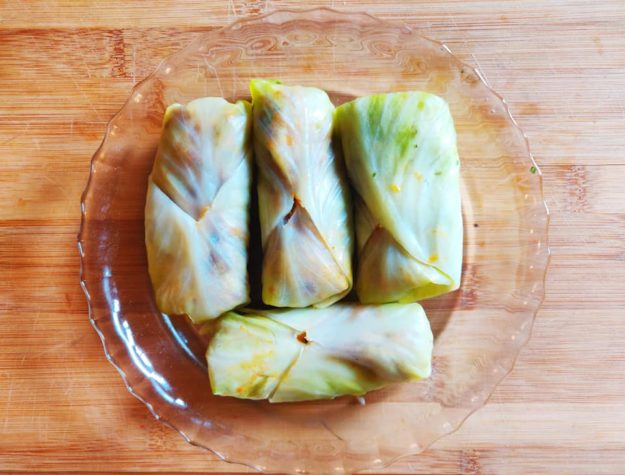Armenians in Bengal and Cabbage Dolma

Hayastan or Armenia was the first country in the world to adopt Christianity as it’s official religion in 301 AD. The Armenians played an important role in world history as merchants and power brokers.
In India, the oldest reference to an Armenian dates back to the year 780 CE, when an Armenian merchant named Thomas Cana landed on the coast of Malabar and was given trading privileges by ruler of Kodangallur .
With the Ottoman and the Safavid conquests of the Armenian highlands in the 15th century CE, many Armenians left their home country and established themselves in Constantinople, Baghdad, Isfahan, and St. Petersburg.
They were invited by emperor Akbar “to come and settle in his dominions” in 17th century and Armenian merchants from New Julfa in Persia arrived in Bengal in 1645. The Armenian merchants, with their command over the Mughal court language – Persian – soon established themselves in Mughal courts and played a key role in securing the royal farman from the Mughals to enable the British to set up their trading posts in Calcutta.
In Bengal, Armenians played both sides of the fence with the Indians and the East India Company. Petrus Arathoon was a close confidante to Lord Clive while his brother Gregory Arathoon adopted the name Gorgin Khan and became the Commander in Chief of Mir Jaffar’s army!
But Armenians were mostly merchants who had deep influences on Bengal’s skyline and cuisine. While they went on to build some iconic structures that adorn the city of Kolkata today – The Oberoi Grand, Stephen House, Park Mansions, Queen’s Mansion, Armenian College and Philanthropic Academy and Davidian Girls’ School, and three churches. The Armenian Ghat on Strand Road and the ghat near Kalighat temple was also built by them.
Their mark on Bengali cuisine is evident in form of the iconic potol’er dorma or pointed gourds stuffed with minced fish, which is considered a delicacy in Bengali food. The Armenians are believed to have brought the Mideastern dolma – grape leaves stuffed with minced meat and rice – with them to Bengal. As the Portuguese introduced cabbages in India somewhere around the same time, the grape leaves were substituted by cabbage leaves in the dolma. These parcels stuffed with minced meat and rice, served on a bed of tomato sauce soon became a part of the early Anglo Indian food in India.
The early Brits who maintained a careful distance from native culture and food, took a more lenient view of adapting from their merchants and power brokers. The dolma entered the British kitchen though the khansamas. Inside the homes, the cabbage dolma often shed it’s grandeur and was made with only rice and Sultanas to suit the delicate stomach of the British. As housekeeping cum cookbooks written by Memsahibs from native colonies became a trend that handheld newcomers in setting up households and entertaining, cabbage dolma was passed down and found place in many dinner menus.
With the passage of time as the intermingling of colonisers and Bengalis became frequent, the dolma morphed into the potol’er dorma in the elite Bengali kitchen. Replete with it’s original Armenian use of raisins, but served on a spicier tomato gravy that suited the local palate. While the potol’er dorma retained it’s place of pride, the cabbage dolma pretty much remained confined to the Anglo-Indian rapporteur and all but fell through the cracks of time.
The Anglo Indian Cabbage Dolma
Cabbage leaves – 8, large; Onions – 4 medium, chopped; Long grained rice – 100 gm; Garlic – 1 clove; Refined oil or butter – 1 tbsp; Sultanas – 50 gm; Tomatoes – 4; Grated nutmeg – couple of pinches; Salt and Pepper – to taste
1. Wash cabbage leaves and immerse them in salted boiling water for 2 minutes. Take out, pat dry and keep aside.
2. Heat oil or butter in a saucepan and sweat the chopped onions and crushed garlic. Add the rice. Saute till rice is glossy.
3. Skin and chop the tomatoes. Add tomatoes, nutmeg, salt and pepper to the saucepan and cook over a medium flame till a smooth gravy is formed. Keep aside.
4. Put spoonfuls of rice mixture on each cabbage leaf. Fold in the sides and roll up the leaves, making a loose package. Place seam side down and secure with toothpicks.
5. Place in a large pan, cover with water and simmer for 45-60 minutes.
6. Serve with tomato gravy.
P.S. One can easily incorporate minced goat meat or flaked fish into the stuffing. The rolls taste better if they are put into a tomato gravy and baked for 10 minutes.



